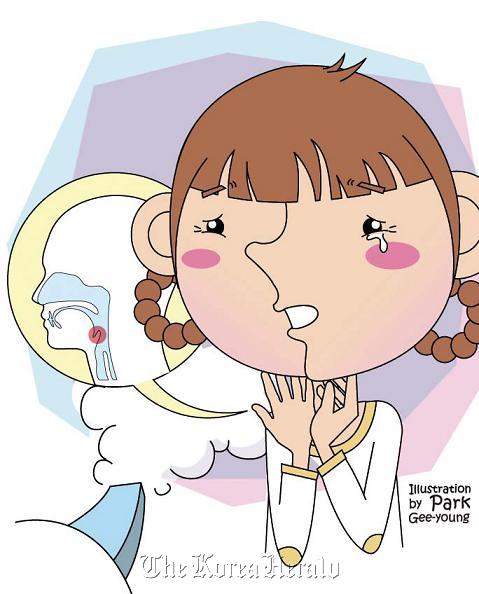The epiglottis is located above the larynx, and plays a key role in keeping food out of the airway by covering the larynx when we swallow. Acute epiglottitis is an acute inflammation of the epiglottis, which mainly occurs due to infection with Haemophilus influenzae. Patients risk having their breathing obstructed if they are faced with severe edema or swelling of the larynx. Because of this, acute epiglottitis is often considered an emergency condition.
Time and age of onset
Epiglottitis occurs predominantly between winter and spring, and common in infants ages 3 and up. But it may occur in any season or age group. Acute epiglottitis is also more prevalent in infants than adults.
Symptoms
The symptoms of acute epiglottitis include high fever, swallowing pain, breathing problems and wheezing. Patients with acute epiglottitis have “hot potato voice,” speaking as if they have a mouthful of hot potato. When these patients lie down, their swollen epiglottis closes the airway and this further aggravates breathing problems.
Patients therefore tend to sit rather than lie down. In addition, patients may dribble due to difficulty swallowing. The difficulty in swallowing may further aggravate the airway obstruction as saliva and mucus collects in the throat.
DiagnosisIn the presence of the above symptoms, it is imperative that patients promptly visit an outpatient clinic and receive an examination and appropriate treatment. On laryngoscopy, the epiglottis is characterized by a bright red color and this is also accompanied by swelling. On radiographs of the neck, the swollen epiglottis is characterized as being thumb-shaped.
In patients who are strongly suspected to have this disease, however, excessive tests or handling might aggravate their condition. This deserves special attention. In principle, no procedures are allowed unless there are preparations for endotracheal intubation or tracheostomy. A diagnosis of acute epiglottitis can be made based on these symptoms and medical examination. In addition, a blood culture test and electrolyte test are also needed to make a diagnosis.
TreatmentAcute epiglottitis quickly causes respiratory difficulty and is potentially fatal when symptoms get severe. Prompt treatment is therefore of prime importance.
Patients with a fever accompanied by respiratory difficulty should visit an emergency care center to receive emergency treatment. Until they reach the hospital, they are recommended to sit up rather than lie down. Distressed patients may have their respiratory difficulty further aggravated.
Patients should therefore remain both calm and quiet. In the treatment of patients with acute epiglottitis, it is of prime importance to secure the airway. This should be followed by antibiotic therapy and conservative treatments. In patients in whom the symptoms are gradually aggravated, the pulse and respiratory rate are elevated and chest wall retraction occurs during respiration. In such cases, an endotracheal intubation or a tracheostomy should be performed.
It is a general treatment principle that an endotracheal tube should be maintained for approximately two days and then an extubation should be followed. The use of steroids may also shorten the time until the extubation. In patients whose airway tract was secured, both blood culture and the antibiotic therapy should be performed. Intravenous injections of antibiotics are needed for at least five days.
Treatments that patients can perform at home include maintaining the humidity at an appropriate level using a humidifier and drinking a sufficient amount of water.
Clinical course, prognosis and complicationsA very good prognosis is expected with prompt diagnosis and treatment. A full recovery is made in most cases of acute epiglottitis. Although rare, stenosis can occur in the area below the glottis. Complications may be of both infectious and non-infectious origin. The former cases include pneumonia due to pathogenic bacteria, and also meningitis, myocarditis, infectious arthritis and otitis media. The latter cases include CNS hypoxic injury, other organ injury and secondary hypoxia due to pulmonary edema.
PreventionPreventive vaccination against Haemophilus influenzae is effective. It has been shown that the incidence of acute epiglottitis markedly decreases in regional areas following preventive vaccinations.

Jeong Han-sin
By Dr. Jeong Han-sin
The author is a professor at Department of Otorhinolaryngology ― Head & Neck Surgery at Sungkyunkwan University School of Medicine, and doctor at Samsung Medical Center. ― Ed.







